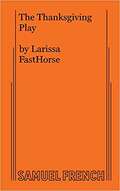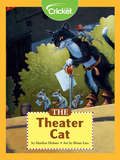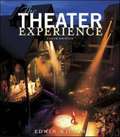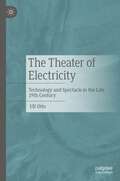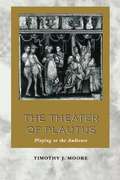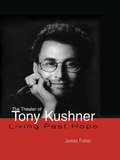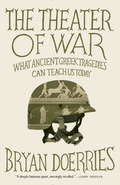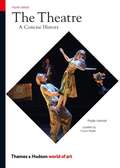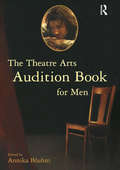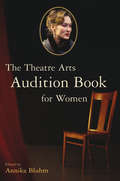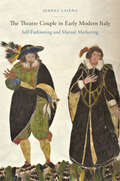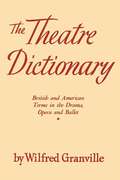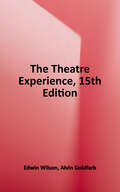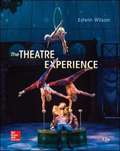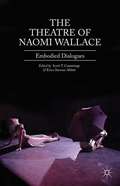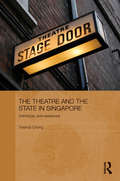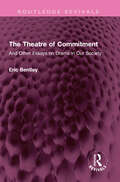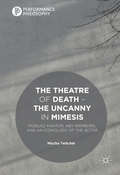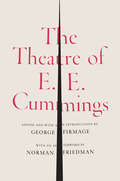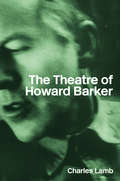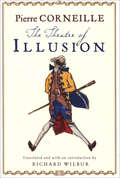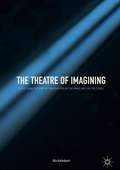- Table View
- List View
The Thanksgiving Play
by Larissa FasthorseGood intentions collide with absurd assumptions in Larissa FastHorse’s wickedly funny satire, as a troupe of terminally “woke” teaching artists scrambles to create a pageant that somehow manages to celebrate both Turkey Day and Native American Heritage Month.
The Theater Cat
by Marilyn HelmerFor generations, the LeChats had kept the mouse problem in the Old Lighthouse Theater under control. But Purrcey LeChat doesn't want to hunt mice—he wants to see his name up in lights!
The Theater Experience (10th Edition)
by Edwin WilsonThe ideal theater appreciation text for courses focusing on theater elements, The Theater Experience encourages students to be active theater-goers as they learn about the fundamentals of a production. By addressing the importance of the audience, Wilson brings the art of performance to life for students who may have little experience with the medium.
The Theater of Electricity: Technology and Spectacle in the Late 19th Century
by Ulf OttoSince the 1880s, electrical energies started circulating in European theaters, generated from fossil fuels in urban power plants. A mysterious force, which was still traded as romantic life force by some and for others had already come to stand in for progress, entered performance venues. Engineering knowledge, control techniques and supply chains changed fundamentally how theater was made and thought of. The mechanical image machine from Renaissance and Baroque times was transformed into a thermodynamic engine. Modern theater turned out to be electrified theater. – Retracing what happened backstage before the Avantgarde took to the front stage, this book proposes to write the genealogy of theaters modernity as a cultural history of theater technology.
The Theater of Plautus: Playing to the Audience
by Timothy J. MooreThe relationship between actors and spectators has been of perennial interest to playwrights. The Roman playwright Plautus (ca. 200 BCE) was particularly adept at manipulating this relationship. Plautus allowed his actors to acknowledge freely the illusion in which they were taking part, to elicit laughter through humorous asides and monologues, and simultaneously to flatter and tease the spectators.<P><P>These metatheatrical techniques are the focus of Timothy J. Moore's innovative study of the comedies of Plautus. The first part of the book examines Plautus' techniques in detail, while the second part explores how he used them in the plays Pseudolus, Amphitruo, Curculio, Truculentus, Casina, and Captivi. Moore shows that Plautus employed these dramatic devices not only to entertain his audience but also to satirize aspects of Roman society, such as shady business practices and extravagant spending on prostitutes, and to challenge his spectators' preconceptions about such issues as marriage and slavery. These findings forge new links between Roman comedy and the social and historical context of its performance.
The Theater of Tony Kushner (Studies in Modern Drama)
by James FisherThe Theater of Tony Kushner is a comprehensive portrait of the life and work of one of America's most important contemporary playwrights.
The Theater of War: What Ancient Greek Tragedies Can Teach Us Today
by Bryan DoerriesThis is the personal and deeply passionate story of a life devoted to reclaiming the timeless power of an ancient artistic tradition to comfort the afflicted. For years, theater director Bryan Doerries has led an innovative public health project that produces ancient tragedies for current and returned soldiers, addicts, tornado and hurricane survivors, and a wide range of other at-risk people in society. Drawing on these extraordinary firsthand experiences, Doerries clearly and powerfully illustrates the redemptive and therapeutic potential of this classical, timeless art: how, for example, Ajax can help soldiers and their loved ones better understand and grapple with PTSD, or how Prometheus Bound provides new insights into the modern penal system. These plays are revivified not just in how Doerries applies them to communal problems of today, but in the way he translates them himself from the ancient Greek, deftly and expertly rendering enduring truths in contemporary and striking English. The originality and generosity of Doerries's work is startling, and The Theater of War--wholly unsentimental, but intensely felt and emotionally engaging--is a humane, knowledgeable, and accessible book that will both inspire and enlighten. Tracing a path that links the personal to the artistic to the social and back again, Doerries shows us how suffering and healing are part of a timeless process in which dialogue and empathy are inextricably linked.From the Hardcover edition.
The Theater of the Bauhaus
by Oskar Schlemmer Arthur S. Wensinger Walter Gropius Lazlo Moholy-Nagy Farkas MolnarFew creative movements have been more influential than the Bauhaus, under the leadership of Walter Gropius. The art of the theater commanded special attention. The text in this volume is a loose collection of essays by Oskar Schlemmer, Laszlo Moholy-Nagy, and Farkas Molnár (who in an illustrated essay shares his vision of a total theatre space), with an introduction by Bauhaus leader Walter Gropius. Originally published in German in 1924, Die Bühne im Bauhaus was translated by A. S. Wensinger and published by Wesleyan in 1961. It was prepared with the full cooperation of Walter Gropius and his introduction was written specially for this edition.From Bauhaus experiments there emerged a new aesthetic of stage design and presentation, a new concept of "total theater." Its principles and practices, revolutionary in their time and far in advance of all but the most experimental stagecraft today, were largely the work of Oskar Schlemmer, Laszlo Moholy-Nagy, and their students. Profusely illustrated and startling in its typography (the work of Moholy-Nagy), the 1924 volume quickly became a collector's item and is now virtually unobtainable. Those interested in the stage, the modern visual arts, or in the bold steps of the men of genius who broadened the horizons of aesthetic experience will appreciate that this translation is available again.
The Theatre A Concise History 4th edition
by Enoch Brater Phyllis HartnollActing, direction, stagecraft, theatre architecture and design, the extraordinary evolution of dramatic literature—here is an all-embracing and richly illustrated history, worldwide in scope and ranging from the ancient origins of the theatre in the choral hymns sung around the altar of Dionysus to the endless variety of forms that theatre takes in our own day. For this fourth edition, Enoch Brater, Professor of English and Theatre at the University of Michigan, has contributed a revised and extended final chapter on contemporary theatre and updated factual information throughout the book
The Theatre Arts Audition Book for Men
by Annika BluhmFirst Published in 2003. Routledge is an imprint of Taylor & Francis, an informa company.
The Theatre Arts Audition Book for Women
by Annika BluhmFirst Published in 2003. Routledge is an imprint of Taylor & Francis, an informa company.
The Theatre Couple in Early Modern Italy: Self-Fashioning and Mutual Marketing (Performing Celebrity)
by Serena LaienaWho were the first celebrity couples? How was their success forged? Which forces influenced their self-fashioning and marketing strategies? These questions are at the core of this study, which looks at the birth of a phenomenon, that of the couple in show business, with a focus on the promotional strategies devised by two professional performers: Giovan Battista Andreini (1576–1654) and Virginia Ramponi (1583–ca.1631). This book examines their artistic path – a deliberately crafted and mutually beneficial joint career – and links it to the historical, social, and cultural context of post-Tridentine Italy. Rooted in a broad research field, encompassing theatre history, Italian studies, celebrity studies, gender studies, and performance studies, The Theatre Couple in Early Modern Italy revises the conventional view of the Italian diva, investigates the deployment of Catholic devotion as a marketing tool, and argues for the importance of the couple system in the history of Commedia dell’Arte, a system that continues to shape celebrity today.
The Theatre Dictionary: British and American Terms in Drama, Opera, and Ballet
by Wilfred GranvilleWilfred Granville’s Theatre Dictionary is an essential guide to the terms in British and American Drama, Opera, and Ballet, and this volume is of incomparable value for the student and practical theatre worker on either side of the Atlantic. It offers a fascinating compilation of technical jargon and colloquial slang pertaining to the business of the theatre, from the legitimate stage to vaudeville and road shows. For several years Wilfred Granville was actively engaged in the theatre as actor, stage director, and producer and speaks from firsthand knowledge of his subject. A specialist in glossaries, Wilfred Granville has treated theatre speech in a readable, unacademic way though there is no inadequacy in his treatment of etymologies of words and phrases recorded. Wilfred Granville was a British lexicographer known for his jargon and slang dictionaries and his military histories. He researched and wrote dictionaries on sea and naval slang and theatre terms as well as naval military histories.
The Theatre Experience
by Edwin Wilson Alvin GoldfarbThe Theatre Experience, 15e prepares students to be well-informed, well-prepared theatre audience members. With an audience-centered narrative that engages today’s students, a vivid photo program that brings concepts to life, and features that teach and encourage a variety of skill sets, students master core concepts and learn to think critically about theatre and the world around them. As a result, students are better prepared for class and better prepared for theatregoing. The textbook is noted for its lively writing style and for helping students recognize how theatre relates to our everyday lives.
The Theatre Experience Thirteenth Edition
by Edwin WilsonThe thirteenth edition of The Theatre Experience is students' ticket to the best seat in the house. From Broadway to makeshift theater spaces around the world, the author demonstrates the active and lively role they play as audience members by engaging them in the collaborative and creative processes behind and in front of the curtain. Wilson introduces students to the roles of the performers, directors, producers and designers, while emphasizing the insights they as audience members bring to any production. The thirteenth edition better accommodates today's teaching schedules, as well as improves accessibility for students by concise insight and up-to-date vibrant production visuals. Students join the creative process with The Theatre Experience, and rehearse for their role as life-long audience members.
The Theatre Experience, Thirteenth Edition
by Edwin WilsonThe Theatre Experience prepares students to be well-informed, well-prepared theatre audience members. With an audience-centered narrative that engages today's students, a vivid photo program that brings concepts to life, and features that teach and encourage a variety of skill sets students master core concepts and learn to think critically about theatre and the world around them.
The Theatre Of Naomi Wallace
by Scott T. Cummings Erica Stevens AbbittNaomi Wallace, an American playwright based in Britain, is one of the more original and provocative voices in contemporary theatre. Her poetic, erotically-charged, and politically engaged plays have been seen in London's West End, off-Broadway, at the Com#65533;die-Fran#65533;aise, in regional and provincial theaters, and on college campuses around the world. Known for their intimate, sensual encounters examining the relationship between identity and power, Wallace's works have attracted a wide range of theatre practitioners, including such important directors as Dominic Dromgoole, Ron Daniels, Jo Bonney, and Kwame Kwei-Armah. Drawing on scholars, activists, historians, and theatre artists in the United States, Canada, Britain, and the Middle East, this anthology of essays presents a comprehensive overview of Wallace's body of work that will be of use to theatre practitioners, students, scholars, and educators alike.
The Theatre Of The Occult Revival
by Edmund B. LinganBased on field research and archival study, this book offers an in-depth exploration of the religious foundations, political and social significance, and aesthetic aspects of the theatre created by several of the most influential leaders of the Occult Revival: Katherine Tingley, Rudolf Steiner, Marie Steiner-von Sivers, Aleister Crowley, Alexander Mathews, and Gerald Gardner. The Occult Revival was an international surge of interest in the supernatural, magic, and Eastern mysticism that thrived in Europe and the United States between the late nineteenth-century and the mid-twentieth-century. By studying the theatre that was developed in affiliation with occult movements, this book shows how theatre contributed to the complication and fragmentation of Western religious culture during the turn-of-the-century Occult Revival and how theatre continues to play a part in the development of occult rituals and beliefs.
The Theatre and the State in Singapore: Orthodoxy and Resistance (Routledge Contemporary Southeast Asia Series)
by Terence ChongThis book provides a comprehensive examination of the contemporary English-language theatre field in Singapore. It describes Singapore theatre as a politically dynamic field that is often a site for struggle and resistance against state orthodoxy, and how the cultural policies of the ruling People’s Action Party (PAP) have shaped Singapore theatre. The book traces such cultural policies and their impact from the early 1960s, and shows how the PAP used theatre – and arts and culture more widely – as a key part of its nation building programme. Terence Chong argues that this diverse theatre community not only comes into regular conflict with the state, but often collaborates with it - depending on the rewards at stake, not to mention the assortment of intra-communal conflicts as different practitioners and groups vie for the same resources. It goes on to explore how new forms of theatre, especially English-language avant garde theatre, represented resistance to such government cultural control; how the government often exerts its power ‘behind-the-scenes’ to preserve its moral legitimacy; and conversely how middle class theatre practitioners’ resistance to state power is strongly influenced by class and cultural capital. Based on extensive original research including interviews with theatre directors and other theatre professionals, the book provides a wealth of information on theatre in Singapore overall, and not just on theatre-state relations.
The Theatre of Commitment: And Other Essays on Drama in Our Society (Routledge Revivals)
by Eric BentleyFirst published in 1967 The Theatre of Commitment presents miscellaneous collection of seven essays written over fifteen years. Eric Bentley deals with themes like is the drama an extinct species; the American drama; what is theatre; the pro and con of political theatre; letter to a would-be playwright and the theatre of commitment. For most people, theatre of commitment is political theater, though Bentley indicates that the word commitment is broad enough to embrace the work of any serious writer even if the commitment is to non-commitment. This is an interesting read for students of theatre and performance studies.
The Theatre of Death – The Uncanny in Mimesis
by Mischa TwitchinThis book is concerned with such questions asthe following: What is the life of the past in the present? How might "thetheatre of death" and "the uncanny in mimesis" allow us to conceive of theafterlife of a supposedly ephemeral art practice? How might a theatricaliconology engage with such fundamental social relations as those between theliving and the dead? Distinct from the dominant expectation that actors shouldappear life-like onstage, why is it that some theatre artists - from Craig toCastellucci - have conceived of the actor in the image of the dead? This bookexplores such questions through the implications of the twofold analogyproposed in its very title: as theatre is to the uncanny, so death is tomimesis; and as theatre is to mimesis, so death is to the uncanny. Walter Benjamin once observed that: "The point at issuein the theatre today can be more accurately defined in relation to the stagethan to the play. It concerns the filling-in of the orchestra pit. The abysswhich separates the actors from the audience like the dead from the living. . . " Ifthe relation between the living and the dead can be thought of in terms of ananalogy with ancient theatre, what about modernity?
The Theatre of E. E. Cummings
by E. E. Cummings George James Firmage Norman FriedmanThe complete collection of E. E. Cummings's writing for the stage, from the most inventive poet of the twentieth century. The Theatre of E. E. Cummings collects in their entirety Cummings's long out-of-print theatrical works: the plays HIM (1927), Anthropos (1930), and Santa Claus (1946), and the ballet treatment Tom (1935). In HIM, a creatively blocked artist and his lover, Me, struggle to bridge the impasse in their relationship and in his art. In Anthropos, a Platonic parable, three "infrahumans" brainstorm slogans while a man sketches on a cave wall; and in Santa Claus, Death and Saint Nick exchange identities. Harriet Beecher Stowe's Uncle Tom's Cabin is reimagined as dance, transforming the novel into a symbolic attack against Evil itself. Cummings's prodigious creativity is on display in each of these works, which are ultimately about the place of the artist outside of society. "DON'T TRY TO UNDERSTAND IT, LET IT TRY TO UNDERSTAND YOU," Cummings famously wrote about his intentions for the stage. Thoughtful and witty, Cummings's dramas are an integral part of his canon.
The Theatre of Howard Barker
by Charles LambIn this second, fully revised edition of his acclaimed study of Barker's work, Charles Lamb sets out to make emotional sense of the characters and their interactions. This is a detailed exploration of the 'scene of seduction' - the challenge, the secret, the abject and the catastrophic, processes which dominate Barker's work. For Lamb, the power of Barker's plays is to be found in the exposure to the irrational and its promotion of a state of unknowing. This revised edition includes: * a new interview with Barker;* a revised introduction, * an updated bibliography * a full production chronology. For students of Barker and for actors and directors working with this unique material, Lamb's book is a vital and illuminating text.
The Theatre of Illusion
by Pierre CorneilleA magician conjures a dramatic adventure of romance and intrigue in this seventeenth-century French tragicomedy by the author of Le Cid.In Pierre Corneille’s sparkling play The Theatre of Illusion, magicians, lovers, and heroes prove that all the world truly is a stage. First performed in 1636, it was pioneering in its use of metatheatrical storytelling. It then vanished from the stage for the next three hundred years—to be revived in 1937 at the Comédie Française. Since then it has been widely considered, in Virginia Scott’s words, “Corneille’s baroque masterpiece.”Today this classic work is available in a translation from one of America’s finest poets and translators of French, Richard Wilbur. Widely praised for his translations of plays by Molière and Racine, Wilbur now turns his poetic grace to this celebration of the comedy of humanity and the magic of life.
The Theatre of Imagining: A Cultural History of Imagination in the Mind and on the Stage
by Ulla KallenbachThis book is the first comprehensive analysis of the fascinating and strikingly diverse history of imagination in the context of theatre and drama. Key questions that the book explores are: How do spectators engage with the drama in performance, and how does the historical context influence the dramaturgy of imagination? In addition to offering a study of the cultural history and theory of imagination in a European context including its philosophical, physiological, cultural and political implications, the book examines the cultural enactment of imagination in the drama text and offers practical strategies for analyzing the aesthetic practice of imagination in drama texts. It covers the early modern to the late modernist period and includes three in-depth case studies: William Shakespeare’s Macbeth (c.1606); Henrik Ibsen’s A Doll’s House (1879); and Eugène Ionesco’s The Killer (1957).
